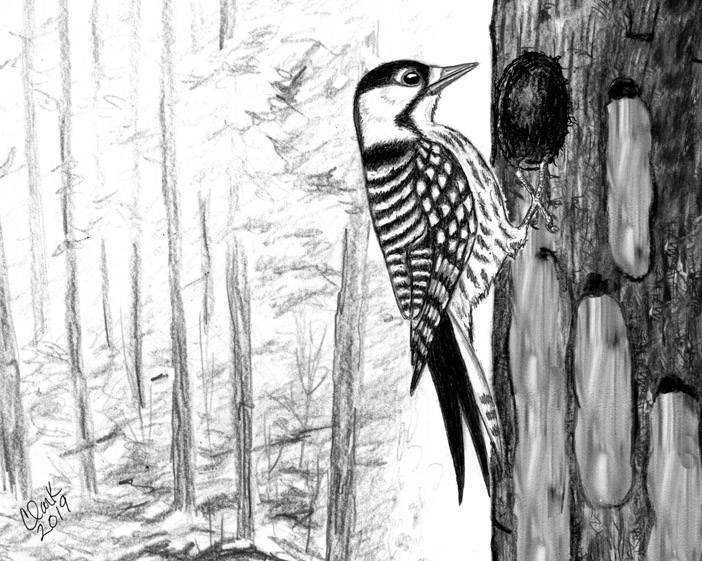
Looking for a new woodpecker,
One of the requirements of being in the retail business is that I must make regular visits to distant trade shows. These shows typically consist of aisles of tacky gift items and lots of weaselly salespeople trying to convince me to buy them. To help make the trips more fun, I often incorporate a bit of local birding. This year’s show is in Atlanta, so my plan is to take a few days to search for the endangered Red-cockaded Woodpecker. These rare birds only breeds in a handful of locations in the Southeast and despite numerous attempts, I’ve never seen one. This time, however, I had some inside information. One of my longtime customers, Reverend Judith, recently retired to North Carolina. Before the good reverend left town, she gave me directions to her favorite Red-cockaded Woodpecker hotspot: the Weymouth Woods Nature Preserve, near the town of Southern Pines, NC. I had never heard of either of these places before, but that’s where I was headed. Hopefully, Rev. Judith’s info will prove to be correct. If not, this could be a disappointing trip…and a very short column.
Compared to most other woodpeckers, the red-cockaded is nothing special to look at. It doesn’t flash yellow, flicker-style, and it’s not majestic, like the Pileated. The attraction, sadly, is its rarity. Not much larger than a Downy Woodpecker, and somewhat similar in appearance, the Red-cockaded Woodpecker earns its name from a nearly impossible-to-see field mark. A “cockade,” so I’m told, is actually a hat decoration. The cockade on this woodpecker is a tiny speck of red on the sides of the male’s head. Once common throughout the Southeast, the bird has nearly disappeared. The reasons for the decline include over-logging of its favorite trees (longleaf pines) and the birds’ restrictive habitat requirements. In order to breed, the birds must find a forest of old (century old) pine trees, with a clear understory below. It is also the only woodpecker in the world that builds its nests exclusively in live trees. Why live trees? Once the nest chamber is dug out, the clever bird pecks tiny holes just below the entrance. This causes sticky sap to run down the side of the tree. What’s the point of that, you ask? To keep snakes from slithering up, of course. Duh!
Southern Pines, which is an hour outside of Raleigh, is a pleasant town, I guess. My focus was on the nearby state park and finding the woodpecker. I needed to get an early start because I already had three strikes against me. I was unfamiliar with the area and my time was limited. But my biggest disadvantage was that I was traveling alone. My wife couldn’t make the trip so I would actually have to find the bird without her help. (Good luck to me.) I arrived at the park just as it opened and went directly to the visitor center. Steve, the ranger, gave me a trail map, highlighted the best places to look for the woodpecker, and sent me on my way. I was immediately encouraged when I found several trees with long lines of sap running down them…and no snakes. (The sap was doing its job.) But after two hours of hiking, I found no woodpeckers. Stupid Steve. I’ll never believe him again.
Before leaving, I spent a few minutes watching the juncos, chickadees (Carolina Chickadees) and towhees eating from the park’s bird feeder. Then two White-breasted Nuthatches landed on the tree above the feeder, but one of the nuthatches looked bigger than the other. It was bigger because it was a woodpecker…a Red-cockaded Woodpecker. Yeah, baby! (I take back what I said about, Steve. He’s the best.) Before I could even reach for my camera, the bird flew off into the forest…with me right behind it. Because the bird lives in woods with little understory, I had no trouble following it. (I only had to look down occasionally for snakes.) Eventually, the bird slowed down long enough for me to snap a few pics. But then things got even better, twice as good in fact. While I was photographing one bird, a second one landed next to it. I had doubled my lifetime count of Red Cockaded Woodpeckers in a matter of seconds. And I did it all without my wife’s help. I only needed guidance from Ranger Steve, a lot of luck, and a little divine intervention from Reverend Judith.
While I was thrilled to find the two Red-cockaded Woodpeckers, my excitement was tempered by the knowledge that these birds are very much endangered. Over the last few centuries their population has dropped by a whopping 99%. Today, a mere few thousand of them are clinging to existence, mostly on government land, including nearby Fort Bragg. The military is proud to be the protectors of the birds and is working hard to ensure their continued existence. But I’m glad I decided to look for them in Weymouth Woods. I doubt the military would be thrilled to see a guy with a camera and a pair of binoculars prowling around its army base. It would not have ended well for me.
My birding outing was over for this trip. It was time to continue on to Hotlanta. The rows of tacky gifts and weaselly salespeople were waiting for me. But I’m already looking forward to going home, so I can brag to my wife about finding the rare woodpeckers without her help. Although, I know what she is going to say. She’ll say that I would have found the birds sooner, and more of them, if she was with me…and she would probably be right.